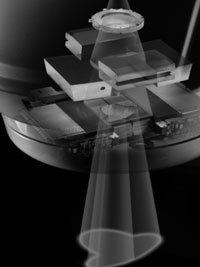Intensity Modulated Radiation Therapy (IMRT)
 IMRT (Intensity Modulated Radiation Therapy) is a very sophisticated modality of radiation therapy that allows physicians to deliver cancer killing radiation doses to a specific target (tumor) volume without treating surrounding healthy tissue thereby reducing side effects.
IMRT (Intensity Modulated Radiation Therapy) is a very sophisticated modality of radiation therapy that allows physicians to deliver cancer killing radiation doses to a specific target (tumor) volume without treating surrounding healthy tissue thereby reducing side effects.
“The primary goal in radiation treatment of cancer,” explains Inder Bhutiani, M.D., board certified radiation oncologist and Medical Director of the Radiation Oncology Department at Winter Haven Hospital, “is to treat the tumor enough to completely destroy it while minimizing side effects. All the advances made at our hospital over the last decade have been focused on that goal. IMRT is the latest technological advancement and is without a doubt, the most significant.”
To best understand the IMRT process, a step-by-step explanation is necessary. Once the radiation oncologist has determined the area and the extent of the cancer, the patient will be scheduled for a CT simulation. This is no different than a diagnostic CT except the patient is scanned in the position that will be duplicated during the daily treatments. The patient then goes home and does not return until the treatment plan has been computed and verified.
The images from the CT are transferred into the treatment planning computer. The treatment planning computer uses the images of the patient and reconstructs the patient’s anatomy in virtual reality similar to slicing an orange and putting the slices back together. At this point, the radiation oncologist “outlines” the cancer and the critical structures on the computer. This is done with the help of all the diagnostic procedures done during the patient’s work up and staging such as other CT scans, Magnetic Resonance Imaging (MRI), Nuclear Medicine scans, etc. In some cases, these other studies can also be imported into the treatment planning computer and superimposed on the CT images allowing the physician to look at both scans simultaneously. The optimal beam arrangement is then determined by the physician as well as the desired radiation treatment doses. The computer then calculates the settings that the treatment machine will use to tailor the delivery of the radiation dose. Once those settings are determined and upon final approval by the radiation oncologist, the patient will be ready to begin daily radiation treatments.
Many cancer patients receiving radiation therapy will benefit from the use of IMRT. “IMRT is especially useful in the treatment of breast cancer, prostate cancer, head and neck cancer, brain cancer, and pancreatic cancer just to name a few. By delivering curable doses of radiation and at the same time minimizing the side effects of the treatment, we will be able to provide more effective state of the art treatment for patients,” states Dr. Bhutiani.
By offer IMRT, our team in Radiation Oncology, including our physicists, dosimetrist, radiation therapy and technologists and secretaries are better able to serve the members of our community and is the only institution in east Polk county providing this service.

